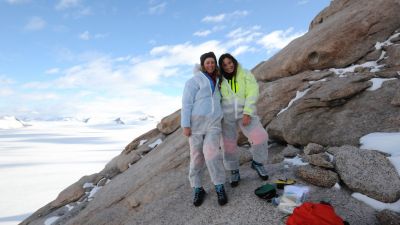
Celebrating the Holidays in Antarctica as Snow Petrel Researchers Arrive
Our team and scientists at the station have been celebrating the Holidays in Antarctica, while continuing their important work to support scientific missions.
On December 23rd, PEA welcomed four new arrivals. A new doctor, Jacques Champagne, replaced Barbara Weith. He’ll serve a tour of two months at the station. We also got a new plumber, Simeon Polet, who is the son of the station’s longtime plumber, Bernard.
The birds next door
Two ornithologists from the UK and Ireland arrived to conduct research on snow petrels (Pagodroma nivea). Eleanor Honan from Durham University and Stephanie Prince from the Royal Society for the Protection of Birds in the UK are working for the ANTSIE project, which is studying behavioral ecology of this species and how climate change may affect the population and life cycles of colonies present in the Sør Rondane Mountains. For their work they will focus on pairs breeding on Utsteinen Nunatak, just 800 metres from the Princess Elisabeth Antarctica.
Eleanor and Stephanie have already started their field work accompanied by Deputy Station Manager Henri Robert (an ornithologist himself). They've already started to monitor the nesting, feeding, and breeding habits of the birds. This is the second time in the history of PEA station that macro-biological research is taking place (several microbiological research projects have already been conducted). Snow petrels are one of the few native animal species that live anywhere near PEA.
These snow-white birds, adapted to living in the extreme environment of Antarctica, typically nest in protective cavities in rocky outcrops sometimes well inland from the cost of Antarctica. Even though they have to fly 200 km to the coast (a trip that takes them four to six hours in each direction!), where they feed on crustaceans and cephalopods from the ocean’s surface, the birds need a safe space to lay their eggs. If they lay them on snow and ice, then their offspring won’t survive, so nunataks are the only place where they can find shelter suitable for breeding despite the distance to the coast.
As the climate in the region may change, this could alter the birds’ living conditions, which could in turn affect their ability to survive.
The scientists are placing GPS trackers on the bird’s central tail feathers and GLS loggers on their tarsus to determine where the birds go to feed and how much time they spend resting or fishing. They also plan to take some stomach content samples, as well as investigate the stomach oils the birds regurgitate in front of their nests (they need to do this from time to time to get rid of excess salt, as they get their food from salt water).
Regurgitated oils as old as 27,000 years old have been found in similar colonies elsewhere in Antarctica, so the species has been living like they currently do for millennia. Hopefully climate change won’t affect their livelihoods and so they can continue to live there for a long time!
Research in the eye of the storm
Weather in Antarctica isn’t always great, even in the middle of the austral summer. Sometimes whiteout conditions prevent anyone from going outside. Visibility can drop to less than a meter if the wind is blowing fallen snow around! Strong winds can accumulate up to several meters of snow on any object sitting on the ice sheet in a very short period of time.
Not only did the team at the station recently have to weather the storm, but the team of glaciologists at the Princess Ragnhild Coast from the MASST2ANT project had to tough it out as well. Thankfully they have a cozy living container that the IPF constructed for them, which allows them to shelter indoors if the weather becomes too inclement. The field guide, Christophe Berclaz, who is on-site with them ,communicates constantly with PEA to know the latest weather forecast, and especially wind direction, so he knows how to best protect their camp.
In about a week the MASS2ANT project will wrap up their mission and return to PEA.
The storm will have passed by then, but another one is arriving at end of the week. This means that researchers from the CLIMB and PEACE projects will need to rush and head back to the Antarctic Plateau before weather conditions degrade again. It will also allow engineers Guus Luppens and Mechanic Tim Grosrenaud to continue testing the new electric Venturi Antarctica vehicle, so they can collect data on how the vehicles performs and report it to the Venturi team.
Always a White Christmas
And of course, like every year, we celebrated Christmas with a wonderful dinner prepared by our amazing cook. The Christmas tree we fashioned from scrap wood went up in the living room of the station to create a festive atmosphere, and we exchanged some small gifts (mostly handmade) between us. We do our best to keep the festive mood, despite being far from family and home at this time of the year.
We look forward to good weather for the New Year!
Picture: Eleanor Honan from Durham University and Stephanie Prince from the Royal Society for the Protection of Birds in the UK are doing research on snow petrels on Utsteinen Nunatak close to PEA - © International Polar Foundation
